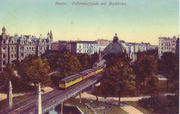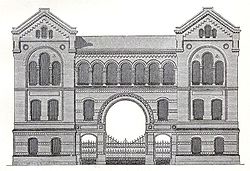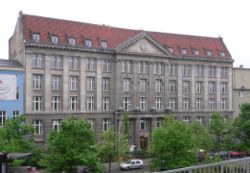
Cremer & Wolffenstein
Encyclopedia

Gründerzeit
' refers to the economic phase in 19th century Germany and Austria before the great stock market crash of 1873. At this time in Central Europe the age of industrialisation was taking place, whose beginnings were found in the 1840s...
in Berlin
Berlin
Berlin is the capital city of Germany and is one of the 16 states of Germany. With a population of 3.45 million people, Berlin is Germany's largest city. It is the second most populous city proper and the seventh most populous urban area in the European Union...
, the years of rapid industrial expansion in Germany
Germany
Germany , officially the Federal Republic of Germany , is a federal parliamentary republic in Europe. The country consists of 16 states while the capital and largest city is Berlin. Germany covers an area of 357,021 km2 and has a largely temperate seasonal climate...
at the end of 19th century, they were a prolific firm in the various aspects of architecture. As one of the largest firms in Berlin at the turn of the century, they designed residential, commercial, transportation, government, and religious buildings. They built a number of synagogue
Synagogue
A synagogue is a Jewish house of prayer. This use of the Greek term synagogue originates in the Septuagint where it sometimes translates the Hebrew word for assembly, kahal...
s, won second place in the 1882 competition to design the Reichstag, and were also involved in planning the Hochbahn overhead railway installation between Kreuzberg
Kreuzberg
Kreuzberg, a part of the combined Friedrichshain-Kreuzberg borough located south of Mitte since 2001, is one of the best-known areas of Berlin...
and Nollendorfplatz
Nollendorfplatz
Nollendorfplatz is a square in the Schöneberg district of Berlin. Colloquially called Nolli it was named in 1864 after the village of Nakléřov , a site of the 1813 Battle of Kulm....
.
Wilhelm Cremer
Wilhelm Albert Cremer was born on 15 November 1854 in CologneCologne
Cologne is Germany's fourth-largest city , and is the largest city both in the Germany Federal State of North Rhine-Westphalia and within the Rhine-Ruhr Metropolitan Area, one of the major European metropolitan areas with more than ten million inhabitants.Cologne is located on both sides of the...
and died 28 March 1919 in Berlin
Berlin
Berlin is the capital city of Germany and is one of the 16 states of Germany. With a population of 3.45 million people, Berlin is Germany's largest city. It is the second most populous city proper and the seventh most populous urban area in the European Union...
. In 1867 he passed the bricklayer master examination, a prerequisite for his longer studies from 1868 to 1875 at the Berliner Bauakademie
Bauakademie
The Bauakademie in Berlin, Germany, built between 1832 and 1836, is considered one of the forerunners of modern architecture due to its theretofore uncommon use of red brick and the relatively streamlined facade of the building.Designed by Karl Friedrich Schinkel, the Bauakademie was built near...
. Parallel to this education he also studied privately with August Orth
August Orth
August Friedrich Wilhelm Orth was a German architect. He was employed by the Strousberg family to provide architectural service for their private accommodation and business ventures...
. After conclusion of his studes he worked as a private architect and as a teacher at the Unterrichtsanstalt des Kunstgewerbemuseums Berlin
Kunstgewerbemuseum Berlin
The Kunstgewerbemuseum, or Museum of Decorative Arts, is an internationally important museum of the decorative arts in Berlin, Germany, part of the Staatliche Museen zu Berlin...
, who appointed him to professor in 1885. In 1878, at the school, he made the acquaintance of another professor Richard Wolffenstein, and in 1882 they created the architecture firm of Cremer & Wolffenstein. With Richard Wolffenstein, on 8 June 1879, he became a founding member of the Vereinigung Berliner Architekten or Union of Berlin Architects, an offshoot of private architects from the Architektenverein zu Berlin. Starting in 1883 he taught additionally at the Technical University of Berlin
Technical University of Berlin
The Technische Universität Berlin is a research university located in Berlin, Germany. Translating the name into English is discouraged by the university, however paraphrasing as Berlin Institute of Technology is recommended by the university if necessary .The TU Berlin was founded...
. In 1907 he was appointed the head of the planning and building department and in 1912 Geheimen Baurat. Few projects of Wilhelm Cremer are known that were not work of the firm, one example is the evangelical church in Neuwied
Neuwied
Neuwied is a town in the north of the German state of Rhineland-Palatinate, capital of the District of Neuwied. Neuwied lies on the right bank of the Rhine, 12 km northwest of Koblenz, on the railway from Frankfurt am Main to Cologne...
of 1880. Although the partner in a firm that designed many synagogues, Cremer was a Christian.
Richard Wolffenstein
Richard Wolffenstein was born on 7 September 1846 in BerlinBerlin
Berlin is the capital city of Germany and is one of the 16 states of Germany. With a population of 3.45 million people, Berlin is Germany's largest city. It is the second most populous city proper and the seventh most populous urban area in the European Union...
and died on 13 April 1919 in Berlin. He was the son of a dye factory owner who studied trade school and acquired the high school diploma in 1864. He had an apprenticeship as a mason between 1864 and 1868 and studied subsequently at the Berliner Bauakademie. Beside his education, he worked in the architecture offices of Kyllmann & Heyden, and Hude & Hennicke. After the master builder examination in 1873, he was active with the architect Wilhelm Neumann specializing in state administration for the next three years. From the years 1876 to 1878, he led an extended study trip through Italy, Holland, England, France and Spain. Through teaching at the Unterrichtsanstalt des Kunstgewerbemuseums Berlins
Kunstgewerbemuseum Berlin
The Kunstgewerbemuseum, or Museum of Decorative Arts, is an internationally important museum of the decorative arts in Berlin, Germany, part of the Staatliche Museen zu Berlin...
from 1878 to 1896 he met Wilhelm Cremer and in 1882 they formed the firm Cremer & Wolffenstein. Richard Wolffenstein was a founding member of the Vereinigung Berliner Architekten on 8 June 1879 and in 1898 was a board member. In 1907 he was a Baurat and in 1912 he was appointed Geheimen Baurat.
Synagogues

Synagogue
A synagogue is a Jewish house of prayer. This use of the Greek term synagogue originates in the Septuagint where it sometimes translates the Hebrew word for assembly, kahal...
s were a speciality of the office, perhaps because of Wolffenstein's Jewish background. The two architects are considered the most important representatives of the building of synagogues of the Gründerzeit. For their work in this field they found inspiration in Dresden's Semper Synagogue
Semper Synagogue
Semper Synagogue, also known as the Dresden Synagogue, was built in 1838-40 for the Jewish community of Dresden by Gottfried Semper. It was an early example of the Moorish Revival style of synagogue architecture. The Semper was the first synagogue to feature the richly ornamented interior that...
(destroyed in 1938 during the Kristallnacht
Kristallnacht
Kristallnacht, also referred to as the Night of Broken Glass, and also Reichskristallnacht, Pogromnacht, and Novemberpogrome, was a pogrom or series of attacks against Jews throughout Nazi Germany and parts of Austria on 9–10 November 1938.Jewish homes were ransacked, as were shops, towns and...
pogrom), the only sacral building by Gottfried Semper
Gottfried Semper
Gottfried Semper was a German architect, art critic, and professor of architecture, who designed and built the Semper Opera House in Dresden between 1838 and 1841. In 1849 he took part in the May Uprising in Dresden and was put on the government's wanted list. Semper fled first to Zürich and later...
, with its simple basic concept and cube formed arrangements. Of the eleven synagogues designed by Cremer & Wolffenstein, eight were built, among them the New Synagogue in Königsberg in Prussia. But all suffered the same fate as their model in Dresden and were destroyed during the Kristallnacht.
In 1996, the Lindenstraße Synagogue was the subject of a memorial designed by Zvi Hecker
Zvi Hecker
Zvi Hecker is a Polish-born Israeli architect. His work is known for its emphasis on geometry and asymmetry.-Biography:Zvi Hecker was born on May 31, 1931 in Krakow, Poland. He grew up in Poland and Samarkand. He began his education in architecture at the Cracow University of Technology. He...
, Eyal Weizmann, and sculptor Micha Ullman. In the courtyard of the present office building, they designed an arrangement of concrete benches placed in the pattern of the seating in the original synagogue. The courtyard and memorial is accessed through a large ground floor opening, much like the central passageway that figured prominently in the Cremer & Wolffenstein synagogue.
Style

Neo-Renaissance
Renaissance Revival is an all-encompassing designation that covers many 19th century architectural revival styles which were neither Grecian nor Gothic but which instead drew inspiration from a wide range of classicizing Italian modes...
influences. Later however they would use a variety of historical styles. The houses and office buildings in the Kaiser-Wilhelm-Straße were among the first Neo-baroque
Neo-baroque
The Baroque Revival or Neo-baroque was an architectural style of the late 19th century. The term is used to describe architecture which displays important aspects of Baroque style, but is not of the Baroque period proper—i.e., the 17th and 18th centuries.Some examples of Neo-baroque architecture:*...
buildings of Berlin. In some works Jugendstil influences can already be found, though their overall tendency was towards eclecticism
Eclecticism
Eclecticism is a conceptual approach that does not hold rigidly to a single paradigm or set of assumptions, but instead draws upon multiple theories, styles, or ideas to gain complementary insights into a subject, or applies different theories in particular cases.It can sometimes seem inelegant or...
.

